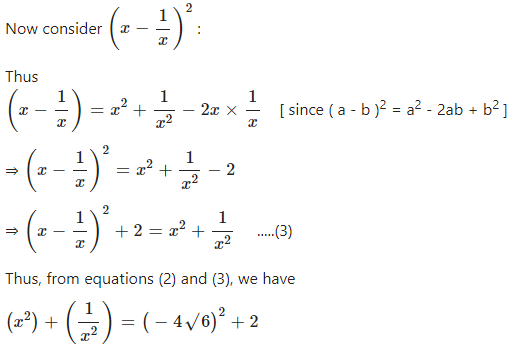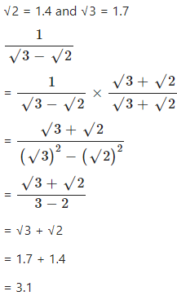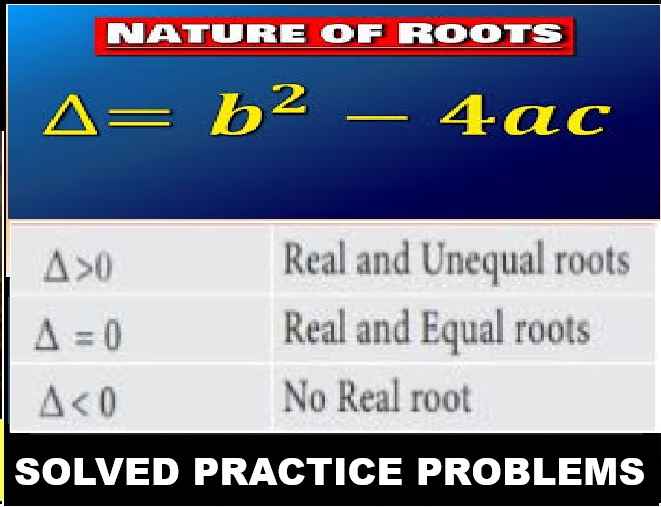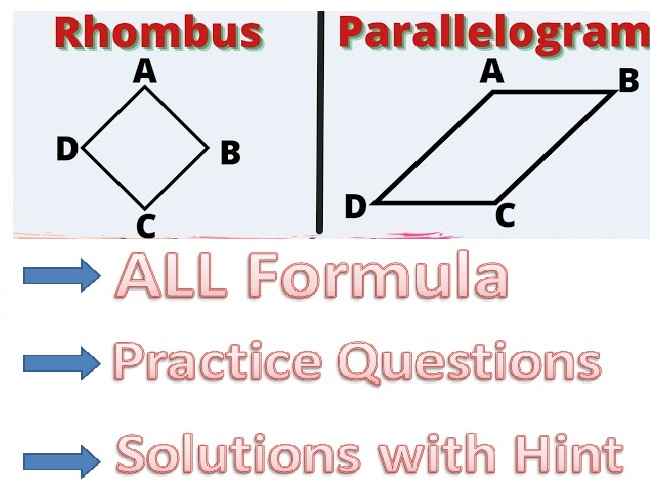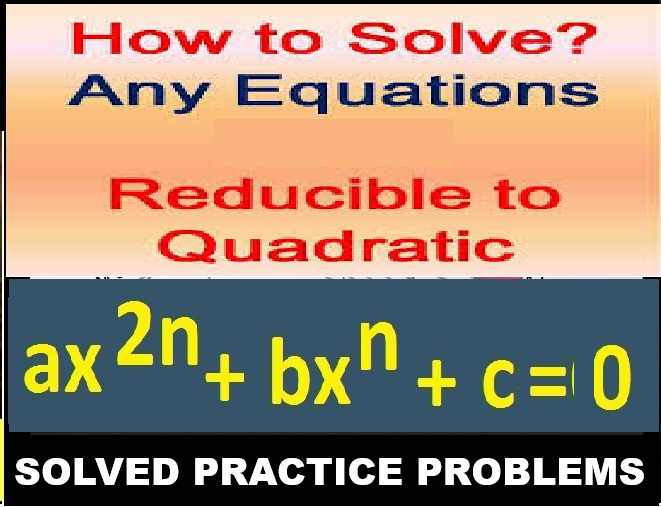Concise Rational and Irrational Numbers ICSE Class-9 Mathematics Selina Solutions Chapter-1 . We provide step by step Solutions of Exercise / lesson-1 Rational and Irrational Numbers for ICSE Class-9 Concise Selina Mathematics by RK Bansal. Our Solutions contain all type Questions with Exe-1 A, Exe-1 B and Exe-1 C , to develop skill and confidence. Visit official Website CISCE for detail information about ICSE Board Class-9.
Concise Rational and Irrational Numbers ICSE Class-9 Mathematics Selina Solutions Chapter-1
–: Select Topics :–
Note:- Before viewing Solution of Chapter -1 Rational and Irrational Numbers Class-9 of Concise Selina Solutions. Read the Chapter Carefully then solve all example given in Exercise-1.1, Exercise-1.2, Exercise-1.3. For more practice on The Rational and Irrational Numbers Visit ML Aggarwal Rational and Irrational Numbers Chapter Also.
Exercise – 1(A) Rational and Irrational Numbers for ICSE Class-9 Maths Concise Selina Solutions
Question 1
Is zero a rational number ? Can it be written in the form , where p and q are integers and q≠0 ?
Answer
Yes, zero is a rational number.
As it can be written in the form of , where p and q are integers and q≠0 ?
⇒ 0 =
Question 2
Are the following statement true or false ? Give reason for your answer.
- Every whole number is a natural number.
- Every whole number is a rational number.
- Every integer is a rational number.
- Every rational number is a whole number.
Answer
i) False, zero is a whole number but not a natural number.
ii) True, Every whole can be written in the formof, where p and q are integers and q≠0.
iii) True, Every integer can be written in the form of , where p and q are integers and q≠0.
iv) False.
Example : is a rational number, but not a whole number.
Question 3
Arrange in ascending order of their magnitudes.
Also, find the difference between the largest and smallest of these rational numbers. Express this difference as a decimal fraction correct to one decimal place.
Answer


Question 4
Arrange in descending order of their magnitudes.
Also, find the sum of the lowest and largest of these fractions. Express the result obtained as a decimal fraction correct to two decimal places.
Answer
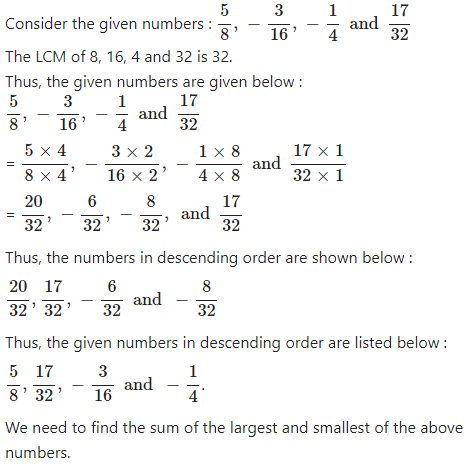
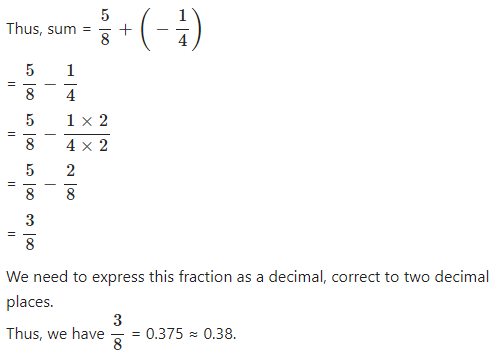
Question 5.1
Without doing any actual division, find which of the following rational numbers have terminating decimal representation :
Answer
Given number is 716
Since 16 = 2 x 2 x 2 x 2 = 24 = 24 x 50
I.e. 16 can be expressed as 2m x 5n
∴ is convertible into the terminating decimal.
Question 5.2
Without doing any actual division, find which of the following rational numbers have terminating decimal representation :
Answer
Given number is
Since 125 = 5 x 5 x 5 = 53 = 20 x 53
I.e. 125 can be expressed as 2m x 5n
∴ is convertible into the terminating decimal.
Question 5.3
Without doing any actual division, find which of the following rational numbers have terminating decimal representation :
Answer
Given number is
Since 14 = 2 x 7 = 21 x 71
I.e. 14 cannot be expressed as 2m x 5n
∴ is not convertible into the terminating decimal.
Question 5.4
Without doing any actual division, find which of the following rational numbers have terminating decimal representation :
Answer
Given number is
Since, 45 = 3 x 3 x 5 = 32 x 51
I.e. 45 cannot be expressed as 2m x 5n
∴ is not convertible into the terminating decimal.
Question 5.5
Without doing any actual division, find which of the following rational numbers have terminating decimal representation :
Answer
Given number is
Since 50 = 2 x 5 x 5 = 21 x 52
I.e. 50 can be expressed as 2m x 5n
∴ is convertible into the terminating decimal.
Question 5.6
Without doing any actual division, find which of the following rational numbers have terminating decimal representation :
Answer
Given number is
Since 40 = 2 x 2 x 2 x 5 = 23 x 51
I.e. 40 can be expressed as 2m x 5n
∴ is convertible into the terminating decimal.
Question 5.7
Without doing any actual division, find which of the following rational numbers have terminating decimal representation :
Answer
Given number is
Since 75 = 3 x 5 x 5 = 31 x 52
i.e. 75 cannot be expressed as 2m x 5n
∴ is not convertible into the terminating decimal.
Question 5.8
Without doing any actual division, find which of the following rational numbers have terminating decimal representation :
Answer
Given number is
Since 250 = 2 x 5 x 5 x 5 = 21 x 53
i.e. 250 can be expressed as 2m x 5n.1
∴ is convertible into the terminating decimal.
End of Exe-1 A Concise Rational and Irrational Numbers for ICSE Class-9
ICSE Class-9 Mathematics Concise Selina Solutions Exercise – 1(B) Rational and Irrational Numbers
Question 1.1
State, whether the following numbers is rational or not : ( 2 + √2 )2
Answer
( 2 + √2 )2 = 22 + 2 ( 2 ) ( √2 ) + ( √2 )2
= 4 + 4√2 + 2
= 6 + 4√2
Irrational number.
Question 1.2
State, whether the following numbers is rational or not : ( 3 – √3 )2
Answer
( 3 – √3 )2 = 32 + 2 ( 3 ) ( √3 ) + ( √3 )2
= 9 – 6√3 + 3
= 12 – 6√3 = 6 ( 2 – √3 )
Irrational number.
Question 1.3
State, whether the following numbers is rational or not : ( 5 + √5 )( 5 – √5 )
Answer
( 5 + √5 )( 5 – √5 ) = ( 5 )2 – ( √5 )2
= 25 – 5 = 20
Rational Number
Question 1.4
State, whether the following numbers is rational or not : ( √3 – √2 )2
Answer
( √3 – √2 )2 = ( √3 )2 – 2 ( √3 )( √2 ) + ( √2 )2
= 3 – 2√6 + 2
= 5 – 2√6
Irrational Number
Question 1.5
State, whether the following numbers is rational or not :
Answer
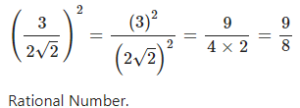
Question 1.6
State, whether the following number is rational or not :
Answer

Question 2.1
Find the square of :
Answer

Question 2.2
Find the square of : √3 + √2
Answer
( √3 + √2 )2 = ( √3 )2 + 2( √3 )( √2 ) + ( √2 )2
= 3 + 2√6 + 2
= 5 + 2√6
Question 2.3
Find the square of : √5 – 2
Answer
( √5 – 2 )2 = ( √5 )2 – 2( √5 )( 2 ) + ( 2 )2
= 5 – 4√5 + 4
= 9 – 4√5
Question 2.4
Find the square of : 3 + 2√5
Answer
( 3 + 2√5 )2 = 32 + 2( 3 )( 2√5) + ( 2√5 )2
= 9 + 12√5 + 20
= 29 + 12√5
Question 3.1
State, in each case, whether true or false :
√2 + √3 = √5
Options
- True
- False
Answer
False
Question 3.2
State, in each case, whether true or false :
2√4 + 2 = 6
Options
- True
- False
Answer
2√4 + 2 = 2 x 2 + 2 = 4 + 2 = 6 which is True.
Question 3.3
State, in each case, whether true or false :
3√7 – 2√7 = √7
Options
- True
- False
Answer
3√7 – 2√7 = √7 – True.
Question 3.4
State, in each case, whether true or false :
27 ia an irrational number.
Options
- True
- False
Answer
False Because 27=0.285714¯ which is recurring and non-terminating and hence it is rational.
Question 3.5
State, in each case, whether true or false :
is a rational number.
Options
- True
- False
Answer
True, because 0.45¯ which is recurring and non-terminating
Question 3.6
State, in each case, whether true or false :
All rational numbers are real numbers.
Options
- True
- False
Answer
True
Question 3.7
state, in each case, whether true or false :
All real numbers are rational numbers.
Options
- True
- False
Answer
False
Question 3.8
State, in each case, whether true or false :
Some real numbers are rational numbers.
Options
- True
- False
Answer
True
Question 4.1

Answer
Given Universal set is
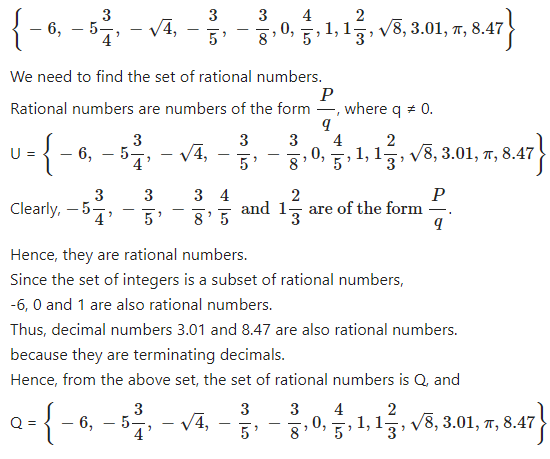
Question 4.2

Answer
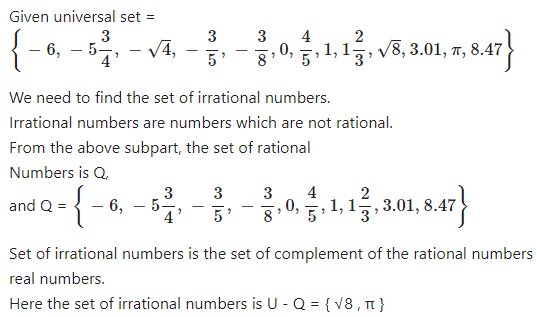
Question 4.3
Given universal set =
`{ -6, -5 3/4, -sqrt4, -3/5, -3/8, 0, 4/5, 1, 1 2/3, sqrt8, 3.01, π, 8.47 }`
From the given set, find : set of integers
Answer
Given Universal set is
`{ – 6, -5 3/4, -sqrt4, -3/5, -3/8, 0, 4/5, 1, 1 2/3, sqrt8, 3.01, π, 8.47 }`
We need to find the set of integers.
Set of integers consists of zero, the natural numbers and their additive inverses.
The set of integers is Z.
Z = `{ …… -3, -2, -1, 0, 1, 2, 3,……. }`
Here the set of integers is U ∩ Z = `{ -6, √4, 0, 1 }`
Question 4.4

Answer

We need to find the set of non-negative integers.
Set of non-negative integers consists of zero and the natural numbers.
The set of non-negative integers is Z+ and Z+ = { 0, 1, 2, 3,…… }
Here the set of integers is U ∩ Z+ = {0, 1}
Question 5
Use method of contradiction to show that √3 and √5 are irrational numbers.
Answer
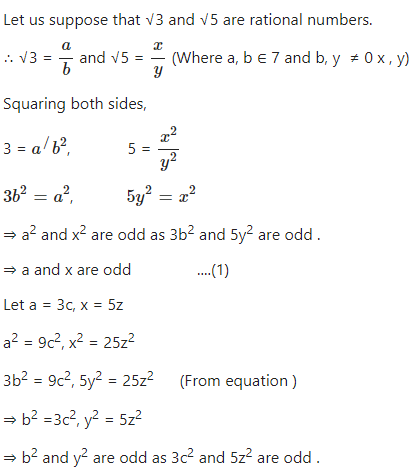
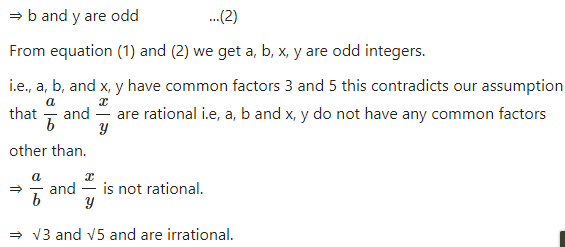
Question 6.1
Prove that the following number is irrational: √3 + √2
Answer
3 + √2
Let √3 + √2 be a rational number.
⇒ √3 + √2 = x
Squaring on both the sides, we get
( √3 + √2 )2 = x2
⇒ 3 + 2 + 2 x √3 x √2 = x2

⇒ x2 is an irrational number.
⇒ x is an irrational number.
But we have assume that x is a rational number.
∴ we arrive at a contradiction.
So, our assumption that √3 + √2 is a rational number is wrong.
∴ √3 + √2 is an irrational number.
Question 6.2
Prove that the following number is irrational: 3 – √2
Answer
3 – √2
Let 3 – √2 be a rational number.
⇒ 3 – √2 = x
Squaring on both the sides, we get
( 3 – √2 )2 = x2
⇒ 9 + 2 – 2 x 3 x √2 = x2
⇒ 11 – x2 = 6√2
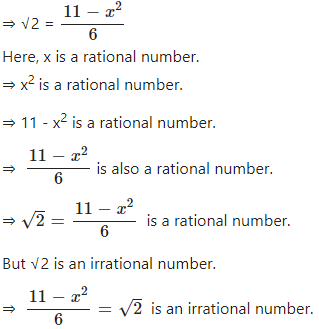
⇒ 11 – x2 is an irrational number.
⇒ x2 is an irrational number.
⇒ x is an irrational number.
But we have assume that x is a rational number.
∴ we arrive at a contradiction.
So, our assumption that 3 – √2 is a rational number is wrong.
∴ 3 – √2 is an irrational number.
Question 6.3
Prove that the following number is irrational: √5 – 2
Answer
√5 – 2
Let √5 – 2 be a rational number.
⇒ √5 – 2 = x
Squaring on both the sides, we get
(√5-2)2=x2
⇒ 5 + 4 – 2 x 2 x √5 = x2
⇒ 9 – x2 = 4√5
⇒ √5 = 9-x24
Here, x is a rational number.
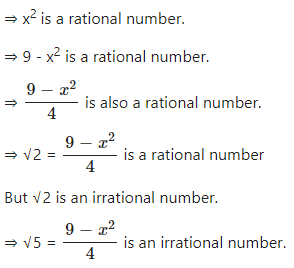
⇒ 9 – x2 is an irrational number.
⇒ x2 is an irrational number.
⇒ x is an irrational number.
But we have assume that x is a rational number.
∴ we arrive at a contradiction.
So, our assumption that √5 – 2 is a rational number is wrong.
∴ √5 – 2 is an irrational number.
Question 7
Write a pair of irrational numbers whose sum is irrational.
Answer
√3 + 5 and √5 – 3 are irrational numbers whose sum is irrational.
( √3 + 5 ) + ( √5 – 3 ) = √3 + √5 + 5 – 3 = √3 + √5 + 2 which is irrational.
Question 8
Write a pair of irrational numbers whose sum is rational.
Answer
√3 + 5 and 4 – √3 are two irrational numbers whose sum is rational.
( √3 + 5 ) + ( 4 – √3 ) = √3 + 5+ 4 – √3 = 9
Question 9
Write a pair of irrational numbers whose difference is irrational.
Answer
√3 + 2 and √2 – 3 are two irrational numbers whose difference is irrational.
( √3 + 2 ) – ( √2 – 3 ) = √3 – √2 + 2 + 3 = √3 – √2 + 5 which is irrational.
Question 10
Write a pair of irrational numbers whose difference is rational.
Answer
√5 – 3 and √5 + 3 are irrational numbers whose difference is rational.
( √5 – 3 ) – ( √5 + 3 ) = √5 – 3 – √5 – 3 = -6 which is rational.
Question 11
Write a pair of irrational numbers whose product is irrational.
Answer
Consider two irrational numbers ( 5 + √2 ) and ( √5 – 2 )
Thus, the product, ( 5 + √2 ) x ( √5 – 2 ) = 5√5 – 10 + √10 – 2√2 is irrational.
Question 12
Write a pair of irrational numbers whose product is rational.
Consider √2 as an irrational number.
√2×√2= √4= 2 which is a rational number.
Question 13.1
Write in ascending order: 3√5 and 4√3
Answer

Question 13.2
Write in ascending order : 253 and323
Answer
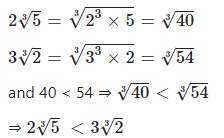
Question 13.3
Write in ascending order : 6√5, 7√3, and 8√2
Answer
6√5 = 62×5=180
7√3 = 72×3=147
8√2 = 82×2=128
and 128 < 147 < 180
∴ √128 < √147 < √180
⇒ 8√2 < 7√3 < 6√5
Question 13.4
Write in ascending order : 6√5, 7√3 and 8√2
Answer
65=62×5=180
73=72×3=147
82=82×2=128
and 128 < 147 < 180
∴ 128<147<180
⇒ 82<73<65
Question 14.1
Write in descending order:
Answer
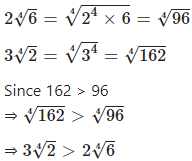
Question 14.2
Write in descending order: 7√3 and 3√7
Answer
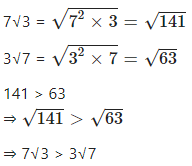
Question 15.1
![]()
Answer
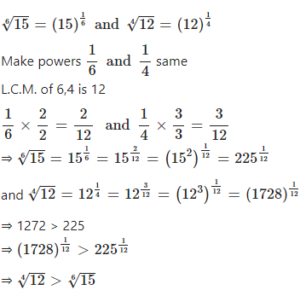
Question 15.2
Compare :
Answer
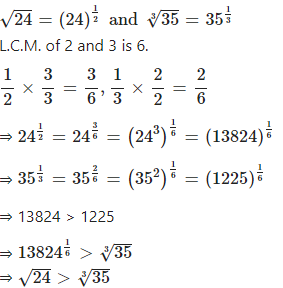
Question 16.
Insert two irrational numbers between 5 and 6.
Answer

Question 17.
Insert five irrational numbers between 2√5 and 3√3.
Answer
We know that 2√5 = 4×5 = √20 and 3√3 = √20
Thus, We have, √20 < √21 < √22 < √23 < √24 < √25 < √26 < √27.
So any five irrational numbers between 2√5 and 3√3 are :
√21, √22, √23, √24, and √26.
Question 18.
Write two rational numbers between √2 and √3.
Answer
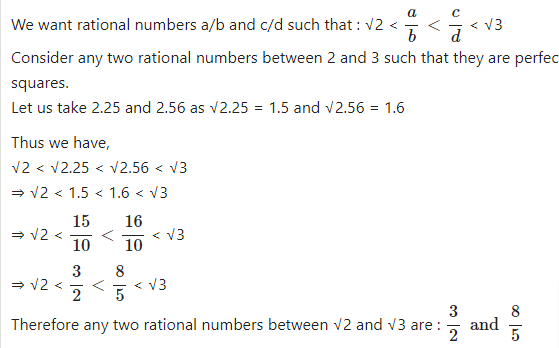
Question 19.
Write three rational numbers between √3 and √5.
Answer
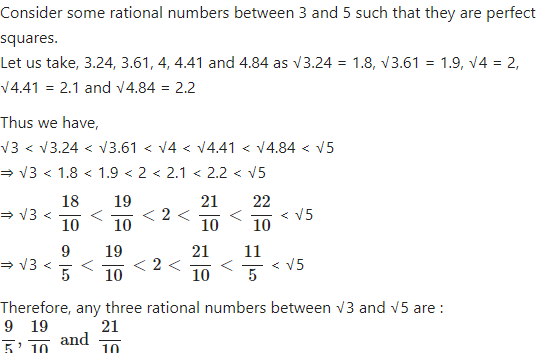
Question 20.1
![]()
Answer
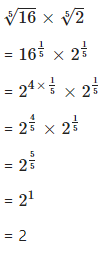
Question 20.2

Answer
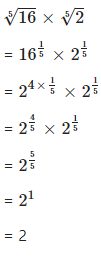
Question 20.3
Simplify : ( 3 + √2 )( 4 + √7 )
Answer
( 3 + √2 )( 4 + √7 )
= 3 x 4 + 3 x √7 + 4 x √2 + √2 x √7
= 12 + 3√7 + 4√2 + √14
Question 20.4
Simplify : (√3 – √2 )2
Answer
(√3 – √2 )2
= ( √3 )2 + ( √2 )2 – 2 x √3 x √2
= 3 + 2 – 2√6
= 5 – 2√6
End of Exe-1 B Concise Rational and Irrational Numbers for ICSE Class-9
Selina Solutions of Exercise – 1(C) Rational and Irrational Numbers Concise Maths for ICSE Class-9
Question 1.1
State, with reason, of the following is surd or not : √180
Answer
√180 = 2×2×5×3×3 = 6√5 which is irrational.
∴ √180 is a surds.
Question 1.2
State, with reason, of the following is surd or not :
Answer

Question 1.3

Answer

Question 1.4

Answer

Question 1.5
State, with reason, of the following is surd or not :
Answer
Question 1.6
State, with reason, of the following is surd or not :
…..
Answer

Question 1.7
State, with reason, of the following is surd or not : √π
Answer
√π not a surds as π is irrational.
Question 1.8
State, with reason, of the following is surd or not :
Answer
is not a surds because 3 + √2 is irrational.
Question 2.1
Write the lowest rationalising factor of : 5√2
Answer
5√2 x 5√2 = 5 x 2 = 10 which is rational.
∴ lowest rationalizing factor is √2
Question 2.2.
Write the lowest rationalising factor of : √24
Answer

Question 2.3
Write the lowest rationalising factor of : √5 – 3
Answer
( √5 – 3 )( √5 + 3 ) = ( √5 )2 – (3)2 = 5 – 9 = -4
∴ lowest rationalizing factor is ( √5 + 3 )
Question 2.4
Write the lowest rationalising factor of : 7 – √7
Answer
7 – √7
( 7 – √7 )( 7 + √7 ) = 49 – 7 = 42
Therefore, lowest rationalizing factor is ( 7 + √7 ).
Question 2.5
Write the lowest rationalising factor of : √18 – √50
Answer

∴ lowest rationalizing factor is √2
Question 2.6
Write the lowest rationalising factor of : √5 – √2
Answer
√5 – √2
( √5 – √2 )( √5 + √2 ) = ( √5 )2 – ( √2 )2 = 3
Therefore lowest rationalizing factor is √5 + √2
Question 2.7
Write the lowest rationalising factor of : √13 + 3
Answer
( √13 + 3 )( √13 – 3 ) = ( √13 )2 – 32 = 13 – 9 = 4
Its lowest rationalizing factor is √13 – 3.
Question 2.8
Write the lowest rationalising factor of : 15 – 3√2
Answer
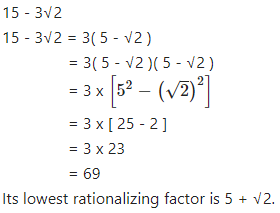
Question 2.9
Write the lowest rationalising factor of : 3√2 + 2√3
Answer
3√2 + 2√3
= ( 3√2 + 2√3 )( 3√2 – 2√3 )
= ( 3√2)2 – (2√3)2
= 9 x 2 – 4 x 3
= 18 – 12
= 6
its lowest rationalizing factor is 3√2 – 2√3.
Question 3.1
Rationalise the denominators of :
Answer
3√5×√5√5=3√5/5
Question 3.2
Rationalise the denominators of :
Answer

Question 3.3
Rationalise the denominators of :
Answer

Question 3.4
Rationalise the denominators of : 3/√5+√2
Answer
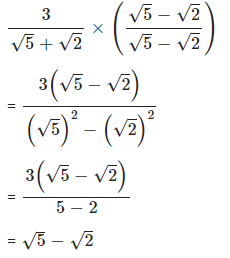
Question 3.5
Rationalise the denominators of :
Answer
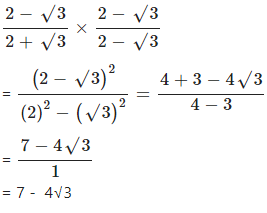
Question 3.6
Rationalise the denominators of :
Answer

Question 3.7
Rationalise the denominators of :
Answer
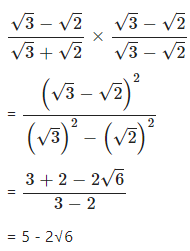
Question 3.8
Rationalise the denominators of :
Answer

Question 3.9
Rationalise the denominators of : …………………
Answer
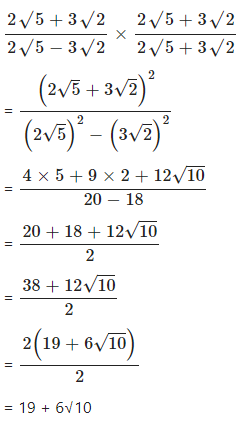
Question 4.1
Find the values of ‘a’ and ‘b’ in each of the following :
………
Answer
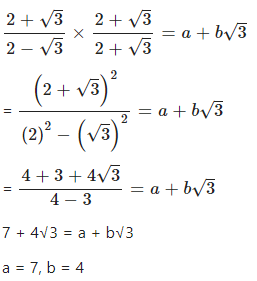
Question 4.2
Find the values of ‘a’ and ‘b’ in each of the following:…..
Answer
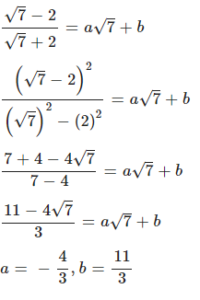
Question 4.3
Find the values of ‘a’ and ‘b’ in each of the following:
Answer
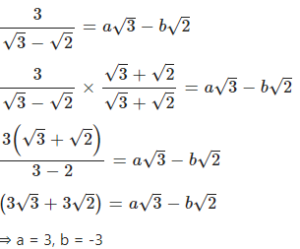
Question 4.4
Find the values of ‘a’ and ‘b’ in each of the following
Answer

Question 5.1
Simplify :
Answer
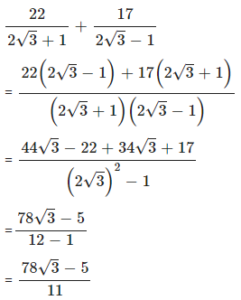
Question 5.2
Simplify :
…………….
Answer

Question 6.1
f x =…………………………find
Answer
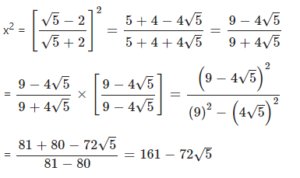
Question 6.2
f x =…………………; find : y2
Answer

Question 6.3
If x =…………………; find : xy
Answer

Question 6.4
If x =………………….; find :
x2 + y2 + xy.
Answer
x2 + y2 + xy
= 161 – 72√5 + 161 +72√5 + 1
= 322 + 1 = 323
Question 7.1
If m = ………… find m2
Answer
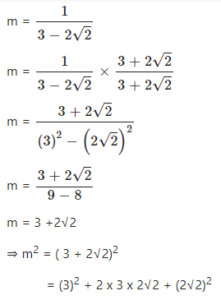

Question 7.2
If m = ……………….., find n2
Answer
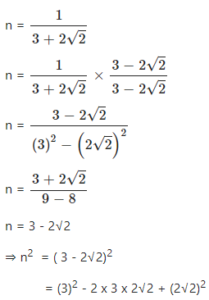
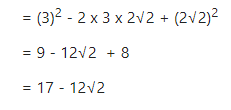
Question 8.1
If x = 2√3 + 2√2 , find : …..
Answer
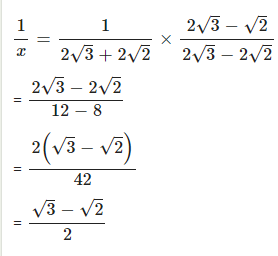
Question 8.2
If x = 2√3 + 2√2 , find : ……..
Answer
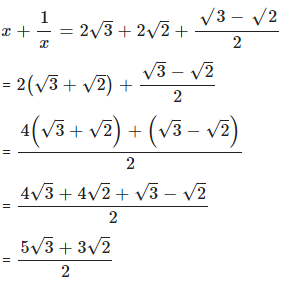
Question 8.3
If x = 2√3 + 2√2 , find :…..
Answer
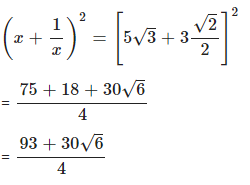
Question 9
If x = 1 – √2, find the value of ……
Answer
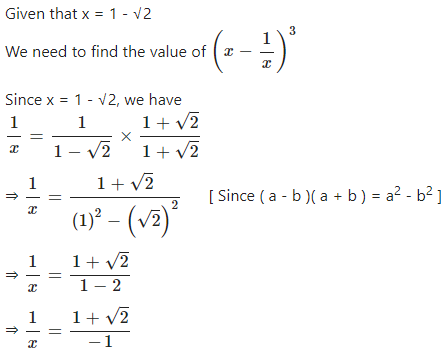
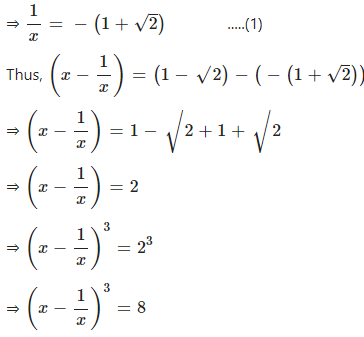
Question 10
If x = 5 – 2√6, find x2+1×2
Answer
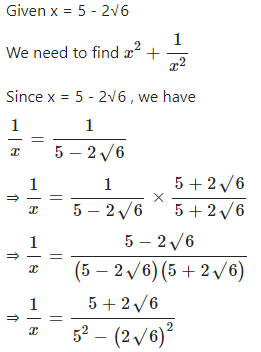

Question 11
Show that : ……………..
Answer

Question 12
Rationalise the denominator of :
Answer

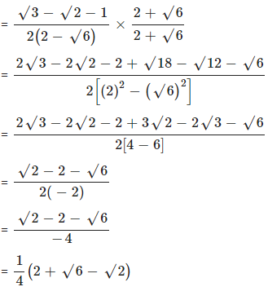
Question 13.1
If √2 = 1.4 and √3 = 1.7, find the value of :…………..
Answer
Question 13.2
If √2 = 1.4 and √3 = 1.7, find the value of : ………
Answer
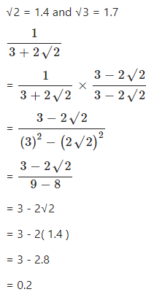
Question 13.3
Simplify :
Answer
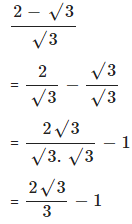
Question 14
Evaluate :
Answer
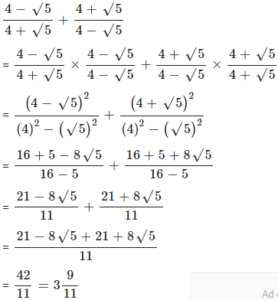
Question 15
If ; find the value of x2 – y2.
Answer
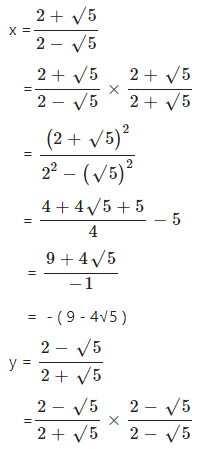
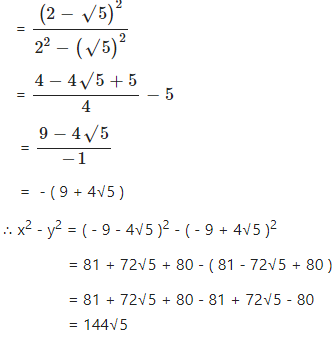
Question 16
Simplify :
Answer
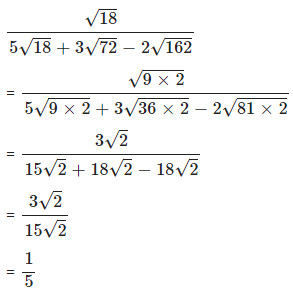
— End of Exe-1 C Concise Rational and Irrational Numbers Solutions :–
Return to – Concise Selina Maths Solutions for ICSE Class -9
Thanks
